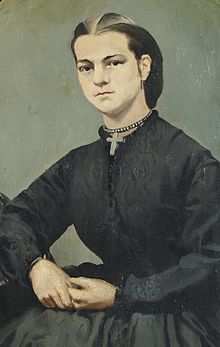Henriette Pauss
Henriette Pauss | |
|---|---|
 Portrait owned by Oslo Museum | |
| Born | Anna Henriette Wegner 2 April 1841 Frogner Manor, Aker |
| Died | 4 April 1918 (aged 77) |
| Resting place | Vår Frelsers gravlund |
| Known for | Teacher, editor and humanitarian and missionary leader |
| Spouse | Bernhard Pauss |
Anna Henriette "Jette" Pauss (2 April 1841, at Frogner Manor in Aker (now Frogner, Oslo) – 4 April 1918, in Christiania), née Anna Henriette Wegner, was a Norwegian teacher, editor, humanitarian and missionary leader and estate owner. With her husband Bernhard Pauss, she was a major figure in girls' education in Norway in the 19th and early 20th centuries. She served as headmistress of the country's preeminent educational institution for girls and women, Nissen's Girls' School, and was extensively involved in other schools and organizations. She was also editor of the journal Santalen and one of the key leaders of the Norwegian Santal Mission that ran schools, hospitals and social projects in India. She was one of the co-owners of Hafslund Manor with two of her siblings until 1894.
Background[edit]

She was born at Frogner Manor and was the youngest daughter of the industrialist Benjamin Wegner and Henriette Seyler.[1] Her parents moved to Norway from Germany in the early 1820s; her father was a co-owner and managing director of Blaafarveværket, owner of Frogner Manor and co-owner of Hassel Iron Works, Hafslund Manor and the timber company of Juel, Wegner & Co.[2][3] Her grandparents were the Hamburg banker L.E. Seyler and Anna Henriette Gossler, for whom she was named. Her mother was a co-owner of her family's bank, Berenberg Bank, and a granddaughter of the Swiss theatre director Abel Seyler.
She was a goddaughter of Countess Karen Wedel-Jarlsberg, Prime Minister Nicolai Johan Lohmann Krog, President of the Parliament Søren Anton Wilhelm Sørenssen, banker Johannes Thomassen Heftye, Prime Minister Frederik Stang, the King's aide-de-camp Hans Christian Rosen, Marie Schjøtt and Henriette Benedicte Løvenskiold.[4] In 1864, her family sold Frognerseteren to her godbrother Thomas Johannessen Heftye.
Together with her sister and her brother George Wegner, she was from 1875 to 1894 one of the main owners of Hafslund Manor, which included sawmills, timber export, around 340,000 decares of forest in Østfold and Østerdalen, and a large number of tenant farms; she and her co-owners sold Hafslund in 1894 to the consortium that marked the beginning of the energy company Hafslund.
In 1876 she married Bernhard Pauss, the headmaster and co-owner of Nissen's Girls' School. They had five children: the surgeon Nikolai Nissen Paus, the lawyer George Wegner Paus and the hydropower executive Augustin Paus, and the daughters Henriette and Louise. She is interred at Vår Frelsers gravlund.[5]
Teaching career and public service[edit]

She and her husband were the leaders and owners of the private Nissen's Girls' School, the pioneer of higher girls' schools in Norway, for several decades. She served as the school's first teacher or headmistress and was the only woman in the school's management from 1885 to 1909.[6][7]
She was also one of the early leaders of the Norwegian Santal Mission, a humanitarian and missionary organisation that was active among the Santhal people of India. In 1907, she succeeded her husband as editor of the organisation's journal Santalen ("The Santal") and also became a member of its executive board, as the first woman elected to the national leadership of a Norwegian missionary organization.[8][9] The village of Pauspur in India was named for her husband.
She was also a member of the board of directors of the School for Young Ladies in Christian Augusts Gade, one of the key leaders and a board member of the Morality Association and a board member of the Association for the Promotion of the Proper Use of Sunday, of which Supreme Court Justice Edward Hambro was chairman. Together with e.g. Moltke Moe, Erik Werenskiold, Gina Krog, Axel Johannessen, Erika Nissen and Bjørnstjerne Bjørnson, she was among the co-authors of the book Forældre og Børn, edited by Aksel Arstal (1902).
References[edit]
- ^ Rolf B. Wegner (Sr.): Familien Wegner, Halden, 1963
- ^ Roede, Lars (2012). "Industriherren Benjamin Wegner på Frogner". Frogner hovedgård: Bondegård, herskapsgård, byens gård. Oslo: Pax forlag. pp. 148–161. ISBN 978-82-530-3496-6.
- ^ Ingerid Hagen (2022). Blåfargen fra Modum: storhetstiden: Blaafarveværket 1822–1848. Stiftelsen Modums Blaafarveværk. ISBN 9788290734584.
- ^ Oslo fylke, Aker, Ministerialbok nr. 16 (1827–1841), Fødte og døpte 1841, p. 217.
- ^ "Enkefru Henriette Pauss' begravelse," in Aftenposten, 13 April 1918, p. 4
- ^ Einar Boyesen (ed.): Nissens pikeskole 1849–1924, Oslo 1924
- ^ Nils A. Ytreberg: Nissen pikeskole 1849–1949, Oslo 1949
- ^ Johan Nyhagen, Santalmisjonens historie; med særlig henblikk på utviklingen i India og Norge, vol. 2, Oslo, 1968, pp. 302ff, passim
- ^ Ivar Holsvik og M.A. Waaler, Festskrift i anledning Santalmissionens 50-aars jubilæum, p. 104, Copenhagen, 1918
